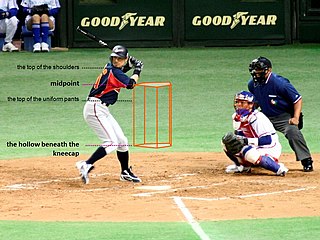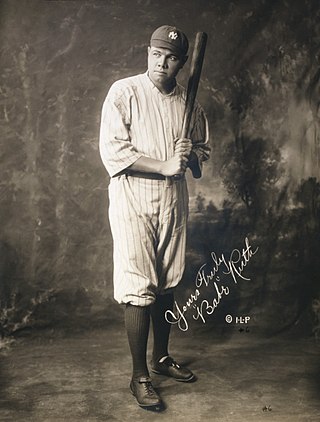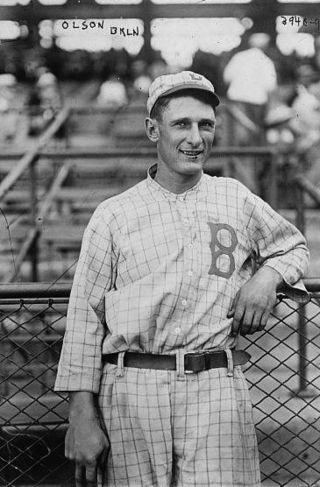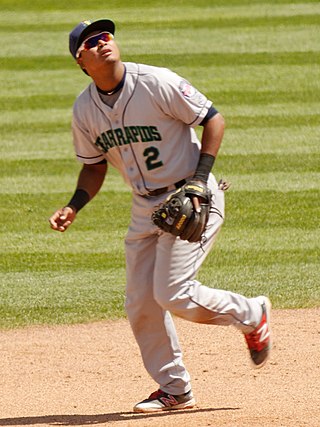Baseball statistics refers to a variety of metrics used to evaluate player and team performance in the game of baseball.

In baseball, an at bat (AB) or time at bat is a batter's turn batting against a pitcher. An at bat is different from a plate appearance. A batter is credited with a plate appearance regardless of what happens during their turn at bat, but a batter is charged with an at bat only if that plate appearance does not have one of the results enumerated below. While at bats are used to calculate certain statistics, including batting average and slugging percentage, a player can qualify for the season-ending rankings in these categories only if they accumulate 502 plate appearances during the season.

A base on balls (BB), better known as a walk occurs in baseball when a batter receives four pitches during a plate appearance that the umpire calls balls, and is in turn awarded first base without the possibility of being called out. The base on balls is defined in Section 2.00 of baseball's Official Rules, and further detail is given in 6.08(a). Despite being known as a "walk", it is considered a faux pas for a professional player to actually walk to first base; the batter-runner and any advancing runners normally jog on such a play.

In baseball statistics, on-base percentage (OBP) measures how frequently a batter reaches base. An official Major League Baseball (MLB) statistic since 1984, it is sometimes referred to as on-base average (OBA), as it is rarely presented as a true percentage.
In baseball, a sacrifice fly is defined by Rule 9.08(d): "Score a sacrifice fly when, before two are out, the batter hits a ball in flight handled by an outfielder or an infielder running in the outfield in fair or foul territory that
- is caught, and a run scores after the catch, or
- is dropped, and a runner scores, if in the scorer's judgment the runner could have scored after the catch had the fly ball been caught."

In baseball, a player is credited with a plate appearance each time he completes a turn batting. Under Rule 5.04(c) of the Official Baseball Rules, a player completes a turn batting when he is put out or becomes a runner. This happens when he strikes out or is declared out before reaching first base; or when he reaches first base safely or is awarded first base ; or when he hits a fair ball which causes a preceding runner to be put out for the third out before he himself is put out or reaches first base safely. A very similar baseball statistic, at bats, counts a subset of plate appearances that end under certain circumstances.

In baseball statistics, slugging percentage (SLG) is a measure of the batting productivity of a hitter. It is calculated as total bases divided by at-bats, through the following formula, where AB is the number of at-bats for a given player, and 1B, 2B, 3B, and HR are the number of singles, doubles, triples, and home runs, respectively:

William Henry Keeler, nicknamed "Wee Willie" because of his small stature, was an American right fielder in Major League Baseball who played from 1892 to 1910, primarily for the Baltimore Orioles and Brooklyn Superbas in the National League, and the New York Highlanders in the American League. Keeler, one of the best hitters of his time, was elected to the National Baseball Hall of Fame in 1939. One of the greatest contact hitters of all time and notoriously hard to strike out, Keeler has the highest career at bats-per-strikeout ratio in MLB history, averaging 63.17 at bats between each strikeout. His plate appearance-per-strikeout ratio is also one of the best of all time, with Keeler averaging 70.66 plate appearances between strikeouts, second only to Joe Sewell, another Hall of Famer, who averaged 73.06 plate appearances between each strikeout.
In baseball, a sacrifice bunt is a batter's act of deliberately bunting the ball, before there are two outs, in a manner that allows a baserunner to advance to another base. The batter is almost always put out, and hence sacrificed, but sometimes reaches base on an error or fielder's choice. In that situation, if runners still advance bases, it is still scored a sacrifice bunt instead of the error or the fielder's choice. Sometimes the batter may safely reach base by simply outrunning the throw to first; this is not scored as a sacrifice bunt but rather a single.

Roy Chester "Beau" Bell was an American professional baseball outfielder. He played in Major League Baseball (MLB) from 1935 to 1941 for the St. Louis Browns, Detroit Tigers, and Cleveland Indians. Bell was named to the 1937 American League All-Star Team.

Joseph Daniel Votto is a Canadian professional baseball first baseman in the Toronto Blue Jays organization. He has previously played in Major League Baseball (MLB) for the Cincinnati Reds, for whom he made his MLB debut in 2007. He was the first Canadian MLB player since Larry Walker to have 2,000 hits, 300 home runs and 1,000 career runs batted in (RBI).

Ivan Massie "Ivy" Olson was an American professional baseball shortstop. He played fourteen seasons in Major League Baseball (MLB) from 1911 to 1924 for the Cleveland Naps, Cincinnati Reds, and Brooklyn Robins.
The 1963 Los Angeles Dodgers were led by pitcher Sandy Koufax, who won both the Cy Young Award and the Most Valuable Player Award. The team went 99–63 to win the National League title by six games over the runner-up St. Louis Cardinals and beat the New York Yankees in four games to win the World Series, marking the first time that the Yankees were ever swept in the postseason.
1903 was the third year for the Detroit Tigers in the still-new American League. The team finished in fifth place with a record or 65–71 (.478), 25 games behind the Boston Americans. The 1903 Tigers outscored their opponents 567 to 539. The team's attendance at Bennett Park was 224,523, sixth out of the eight teams in the AL.
The 1971 Detroit Tigers finished in second place in the American League East with a 91–71 record, 12 games behind the Orioles. They outscored their opponents 701 to 645. They drew 1,591,073 fans to Tiger Stadium, the second highest attendance in the American League.
The Tigers entered the season as the reigning World Series champions. The 1985 Detroit Tigers finished in third place in the American League East with a record of 84–77 (.522), 15 games behind the Blue Jays. The Tigers outscored their opponents 729 to 688. The Tigers drew 2,286,609 fans to Tiger Stadium in 1983, ranking 3rd of the 14 teams in the American League.

In baseball, batting average (BA) is determined by dividing a player's hits by their total at-bats. It is usually rounded to three decimal places and read without the decimal: A player with a batting average of .300 is "batting three-hundred". If necessary to break ties, batting averages could be taken beyond the .001 measurement. In this context, .001 is considered a "point", such that a .235 batter is 5 points higher than a .230 batter.

Luis Sangel Arráez is a Venezuelan professional baseball infielder for the San Diego Padres of Major League Baseball (MLB). He has previously played in MLB for the Minnesota Twins and Miami Marlins. Arráez represents the Venezuelan national team in international competitions.











